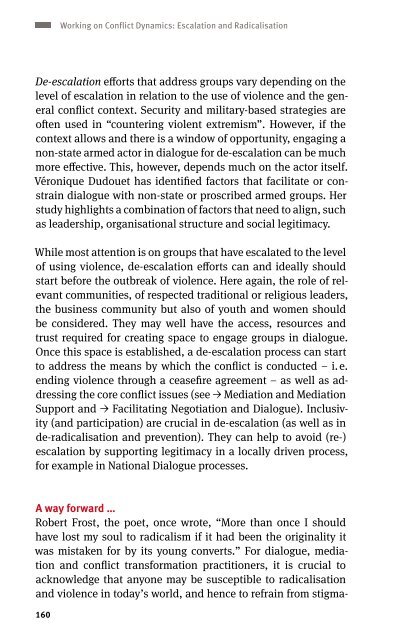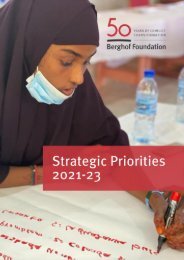Berghof Glossary on Conflict Transformation
The Berghof Glossary on Conflict Transformation presents 20 of the main principles and approaches used by the Berghof Foundation in its work. It is a concise and accessible exploration of what it takes to create “space for conflict transformation”. 2019 edition.
The Berghof Glossary on Conflict Transformation presents 20 of the main principles and approaches used by the Berghof Foundation in its work. It is a concise and accessible exploration of what it takes to create “space for conflict transformation”. 2019 edition.
Create successful ePaper yourself
Turn your PDF publications into a flip-book with our unique Google optimized e-Paper software.
Working <strong>on</strong> C<strong>on</strong>flict Dynamics: Escalati<strong>on</strong> and Radicalisati<strong>on</strong><br />
De-escalati<strong>on</strong> efforts that address groups vary depending <strong>on</strong> the<br />
level of escalati<strong>on</strong> in relati<strong>on</strong> to the use of violence and the general<br />
c<strong>on</strong>flict c<strong>on</strong>text. Security and military-based strategies are<br />
often used in “countering violent extremism”. However, if the<br />
c<strong>on</strong>text allows and there is a window of opportunity, engaging a<br />
n<strong>on</strong>-state armed actor in dialogue for de-escalati<strong>on</strong> can be much<br />
more effective. This, however, depends much <strong>on</strong> the actor itself.<br />
Vér<strong>on</strong>ique Dudouet has identified factors that facilitate or c<strong>on</strong>strain<br />
dialogue with n<strong>on</strong>-state or proscribed armed groups. Her<br />
study highlights a combinati<strong>on</strong> of factors that need to align, such<br />
as leadership, organisati<strong>on</strong>al structure and social legitimacy.<br />
While most attenti<strong>on</strong> is <strong>on</strong> groups that have escalated to the level<br />
of using violence, de-escalati<strong>on</strong> efforts can and ideally should<br />
start before the outbreak of violence. Here again, the role of relevant<br />
communities, of respected traditi<strong>on</strong>al or religious leaders,<br />
the business community but also of youth and women should<br />
be c<strong>on</strong>sidered. They may well have the access, resources and<br />
trust required for creating space to engage groups in dialogue.<br />
Once this space is established, a de-escalati<strong>on</strong> process can start<br />
to address the means by which the c<strong>on</strong>flict is c<strong>on</strong>ducted – i. e.<br />
ending violence through a ceasefire agreement – as well as addressing<br />
the core c<strong>on</strong>flict issues (see → Mediati<strong>on</strong> and Mediati<strong>on</strong><br />
Support and → Facilitating Negotiati<strong>on</strong> and Dialogue). Inclusivity<br />
(and participati<strong>on</strong>) are crucial in de-escalati<strong>on</strong> (as well as in<br />
de-radicalisati<strong>on</strong> and preventi<strong>on</strong>). They can help to avoid (re-)<br />
escalati<strong>on</strong> by supporting legitimacy in a locally driven process,<br />
for example in Nati<strong>on</strong>al Dialogue processes.<br />
A way forward …<br />
Robert Frost, the poet, <strong>on</strong>ce wrote, “More than <strong>on</strong>ce I should<br />
have lost my soul to radicalism if it had been the originality it<br />
was mistaken for by its young c<strong>on</strong>verts.” For dialogue, mediati<strong>on</strong><br />
and c<strong>on</strong>flict transformati<strong>on</strong> practiti<strong>on</strong>ers, it is crucial to<br />
acknowledge that any<strong>on</strong>e may be susceptible to radicalisati<strong>on</strong><br />
and violence in today’s world, and hence to refrain from stigma-<br />
160










